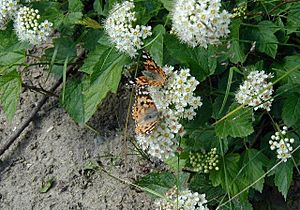Mallow ninebark facts for kids
Quick facts for kids Mallow ninebark |
|
|---|---|
 |
|
| Conservation status | |
| Scientific classification | |
| Genus: |
Physocarpus
|
| Species: |
malvaceus
|
The Mallow Ninebark (Physocarpus malvaceus) is a cool flowering plant that belongs to the rose family. You can find this plant growing naturally in western North America. It stretches from British Columbia in Canada all the way down to Nevada and Wyoming in the United States.
Contents
What the Mallow Ninebark Looks Like
This plant is a type of shrub that loses its leaves in the fall, just like many trees. It usually grows to be about 7 feet (2.1 meters) tall, but some can reach up to 10 feet (3 meters)! It can also grow very close together, forming thick, dense groups called thickets.
The branches of the Mallow Ninebark are smooth. Older branches have bark that looks like it's peeling off in strips, which is why it's sometimes called "ninebark." Its leaves have three to five main points, or "lobes," and their edges are slightly jagged, like a saw. In the summer, the leaves are a dark green color. But when fall arrives, they change to a pretty brownish-red.
In spring, the plant grows clusters of small, white flowers. Each flower has petals that are only about 4 millimeters long, which is less than half a centimeter! After the flowers, small fruits grow. These fruits are called follicles and are about one centimeter long.
Where the Mallow Ninebark Grows
You can find the Mallow Ninebark in different kinds of natural areas. It likes to grow in forests, woodlands, and areas with oak trees. It often grows alongside other plants like oceanspray, common snowberry, and white spirea.
In some forests, the Mallow Ninebark grows with tall trees such as subalpine fir, grand fir, Engelmann spruce, Douglas-fir, and ponderosa pine. It's especially common to see it growing with Douglas-fir trees.
How it Survives Fire
The Mallow Ninebark is a very tough plant! It's known as a "pioneer species." This means it's one of the first plants to grow back after something big happens to the land, like a wildfire or when trees are cut down.
When a fire burns through an area, the Mallow Ninebark doesn't just disappear. It's considered "fire-resistant" because it can survive the flames. After a fire, it quickly sprouts new shoots from its underground stems, called rhizomes. This helps it become even more common in burned areas than in places that haven't had a fire. However, as bigger trees grow back and create more shade, the Mallow Ninebark tends to become less common.
Animals and the Mallow Ninebark
While many animals don't usually eat the Mallow Ninebark, it's still very important for wildlife. It provides great hiding spots and shelter for small animals.
Birds also use this plant. For example, the Dusky Flycatcher (Empidonax oberholseri) often builds its nests right inside the Mallow Ninebark shrubs. This gives their nests good protection.
Mallow Ninebark and Forest Growth
Sometimes, the Mallow Ninebark can grow so well after a disturbance like a fire or logging that it makes it harder for new conifer trees (like pine or fir seedlings) to grow back. It can take up a lot of space and sunlight, which new tree seedlings need. In some places, people might use special sprays to control its growth, helping the young trees get a better start.


